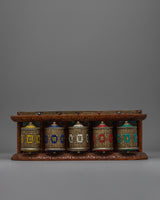
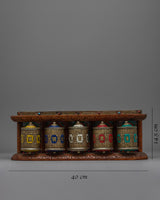
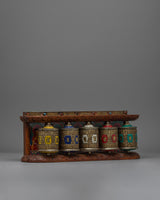
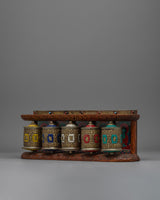
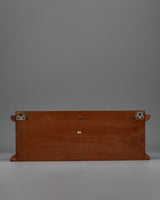
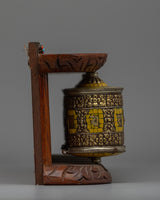
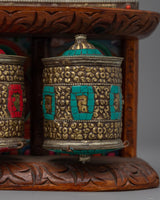
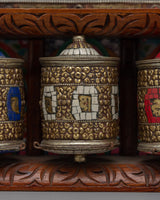
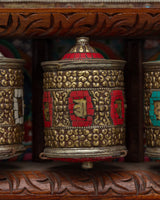
Tibetan Prayer Wheel (Wall Mount) | Beautifully Designed for Both Devotional Use and Home Decor

100% AUTHENTIC

HANDMADE

FREE SHIPPING
Tibetan Prayer Wheel (Wall Mount)
About our Prayer Wheel
A carefully made spiritual object composed of brass and copper, the Tibetan Prayer Wheel (Wall Mount) embodies traditional Tibetan creativity. This prayer wheel has a remarkable 5-in-1 design that combines multiple prayer wheels into a single, unified piece. It is 14.5 cm in height and 40 cm in width. The mix of brass and copper increases its endurance, giving it a rich, ornamental appearance that emphasizes its spiritual value.
The prayer wheel, which comes with a beautiful wooden frame and is wall-mountable, perfectly complements meditation areas and spiritual shrines. The precise craftsmanship of the metallic wheels is complemented by the strong and visually beautiful hardwood frame. This wall-mounted prayer wheel enhances any sacred area by combining traditional workmanship with useful functionality. It is both a lovely ornamental piece and a useful instrument for spiritual practice.
Introduction to Prayer Wheel
A prayer wheel is a cylindrical wheel on a spindle used in Tibetan Buddhism. It is typically inscribed with the mantra "Om Mani Padme Hum" and rotated by hand as a form of spiritual practice and to accumulate merit. Spinning the wheel is believed to have the same spiritual benefits as verbally reciting the mantra. The use of prayer wheels is widespread in Tibetan Buddhism and has spread to other cultures.
--------------------------------------------
Size: 14.5 cm(Height) x 40 cm(Width)
Weight: 1.66 kg
Material: Copper, Brass, Wood
--------------------------------------------
How does the Buddhist Prayer Wheel benefit us?
The benefits associated with rotating the wheel are numerous. It promotes knowledge, compassion, and bodhicitta in the practitioner and improves siddhis (spiritual powers such as clairvoyance, precognition, etc.). The practitioner can repeat the mantra as often as possible while the wheel is rolling, maintaining a calm, meditative attitude. A Tibetan Buddhist tradition holds that at the completion of a practice session, one should dedicate any acquired merits to the benefit of all sentient beings. Then three times Om Ah Hum. This is usually among Tibetans after finishing any Buddhist practice, including the prayer wheel exercise.
-------------------------------------------------------------



















